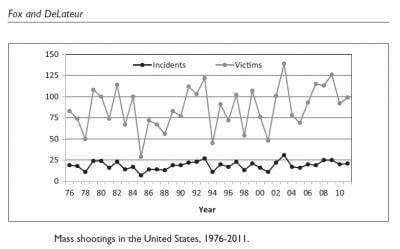With the one-year anniversary of the school shooting in Newtown, Connecticut, many are left with questions about what leads to this and similar tragedies throughout the U.S. While some have theorized about the common personality traits of mass murderers, the frequency of these incidents, and the policy that can stop them, such speculation has led to many myths and misconceptions. New research published in Homicide Studies finds that public policy based on these myths has a limited possibility of decreasing the rate of mass murders and that more drastic measures should be taken to have real success.
“Many of the well-intentioned proposals coming in response to the recent spike in mass shootings may do much to impact the level of violent crime that plagues our nation daily,” the researchers stated. “We shouldn’t, however, expect such efforts to take a big bite out of crime in its most extreme form.”
Researchers James Alan Fox and Monica J. DeLateur analyzed research and important statistics to debunk 11 common myths surrounding mass shootings including:
- Mass murderers snap and kill randomly.
- Mass murderers typically plan their assaults days, weeks, or months in advance. Their motives are most typically revenge, power, loyalty, terror, and profit.
- Mass shootings are on the rise.
- According to FBI data, over the past few decades there has been an average of 20 mass shootings a year in the U.S.
- Violent entertainment, especially video games are causally linked to mass murder.
- Scientists have not found a causal link between video games and mass murder; violent video gaming may be a symptom and not a cause of the incidents.
- There are telltale signs that can help us to identify mass murderers before they act.
- Murderers tend to be male Caucasians with psychological issues, but these characteristics apply to a very large portion of the population.
- Widening the availability of mental-health services will allow unstable individuals to get the treatment they need and decrease mass murders.
- Increasing mental health facilities may not reach those on the fringe who would turn to murder as many see the blame residing in others, not themselves.
- Enhanced background checks will keep dangerous weapons out of the hands of murderers.
- A recent examination of 93 mass shootings from 2009 through September 2013, conducted by Mayors Against Illegal Guns (2013), found no indication that any of the assailants were prohibited by federal law from possessing firearms because of mental illness.
- Having armed guards at schools will protect students from active shooters.
- 28% of public schools already employ armed security personal regularly; there is no way for armed guards to sufficiently protect every single one of their students in an event of a mass shooting.
While the researchers debunk these myths in their research, they state that only more drastic policy would lead to real solutions:
“Taking a nibble out of the risk of mass murder, however small, would still be a worthy goal for the nation,” the authors stated.
“However … eliminating the risk of mass murder would involve extreme steps that we are unable or unwilling to take—abolishing the Second Amendment, achieving full employment, restoring our sense of community, and rounding up anyone who looks or acts at all suspicious. Mass murder just may be a price we must pay for living in a society where personal freedom is so highly valued.”


